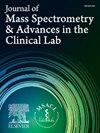Validation of an LC-MS/MS method for urinary homovanillic and vanillylmandelic ACIDS and application to the diagnosis of neuroblastoma
IF 3.4
4区 医学
Q2 MEDICAL LABORATORY TECHNOLOGY
Journal of Mass Spectrometry and Advances in the Clinical Lab
Pub Date : 2025-04-01
DOI:10.1016/j.jmsacl.2025.04.007
引用次数: 0
Abstract
Background
Urinary catecholamine metabolites are well-established biomarkers for neuroblastoma (NB). Homovanillic acid (HVA) and vanillylmandelic acid (VMA) are the most frequently measured metabolites within SIOPEN – Catecholamine Working Group laboratories. Here, we evaluated the performance of a new LC-MS/MS in vitro diagnostic (IVD) kit for HVA and VMA to facilitate inter-laboratory harmonization.
Methods
HVA and VMA and their deuterated internal standards were analyzed with a commercial method, on a ThermoFisher Quantiva LC-MS/MS. Validation was performed first using internal quality control and external quality assessment (IQC and EQA) samples. Next by clinical validation on 120 samples, previously tested by HPLC-ECD. Finally, 36 samples were exchanged between SIOPEN reference laboratories and analyzed by three methods.
Results
Using QCs and EQA the method was validated in a wide calibration range (4.61–830 µmol/L for HVA and 4.44–800 µmol/L for VMA). Intra-day CVs (n = 5) were 7 and 8 % for HVA and 5 and 6 % for VMA for QC low and QC high, respectively; Inter-day CV% were 7 and 3 % for HVA and 2 and 7 % for VMA at QC low and QC high, respectively. Its application to 120 clinical samples confirmed a high diagnostic accuracy. The inter-laboratory quality control assessment showed interchangeable results (p = 0,73 and p = 0.15 for HVA and VMA, respectively).
Conclusion
The LC-MS/MS IVD method could be considered a useful tool for clinical laboratories involved in the measurement of catecholamines, contributing to harmonization efforts.
LC-MS/MS检测尿同型香草酸和香草酸的方法及其在神经母细胞瘤诊断中的应用
尿儿茶酚胺代谢物是神经母细胞瘤(NB)公认的生物标志物。高香草酸(HVA)和香草扁桃酸(VMA)是SIOPEN -儿茶酚胺工作组实验室中最常测量的代谢物。在这里,我们评估了一种新的LC-MS/MS体外诊断(IVD)试剂盒对HVA和VMA的性能,以促进实验室间的协调。方法采用商用方法,在ThermoFisher Quantiva LC-MS/MS上对shva和VMA及其氘化内标进行分析。首先使用内部质量控制和外部质量评估(IQC和EQA)样品进行验证。接下来对120个样品进行临床验证,之前通过HPLC-ECD检测。最后,36份样品在SIOPEN参考实验室间交换,采用三种方法进行分析。结果采用质谱仪和EQA验证了该方法的校准范围(HVA为4.61 ~ 830µmol/L, VMA为4.44 ~ 800µmol/L)。QC低和QC高的HVA和VMA的日内cv (n = 5)分别为7%和8%和5%和6%;在QC低和QC高时,HVA的日间CV分别为7%和3%,VMA的日间CV分别为2%和7%。对120个临床样本的应用证实了其较高的诊断准确性。实验室间质量控制评价结果可互换(HVA和VMA分别为p = 0,73和p = 0.15)。结论LC-MS/MS IVD方法可作为临床实验室儿茶酚胺含量测定的有效工具,有助于儿茶酚胺含量的统一。
本文章由计算机程序翻译,如有差异,请以英文原文为准。
求助全文
约1分钟内获得全文
求助全文
来源期刊

Journal of Mass Spectrometry and Advances in the Clinical Lab
Health Professions-Medical Laboratory Technology
CiteScore
4.30
自引率
18.20%
发文量
41
审稿时长
81 days
 求助内容:
求助内容: 应助结果提醒方式:
应助结果提醒方式:


